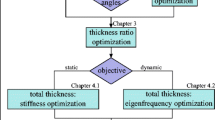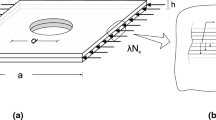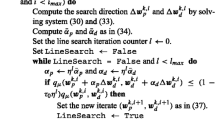Abstract
The object of the study was to optimize composite plates concerning free vibration frequencies, buckling loads, and deflections under constant pressure. Layups without coupling between bending and extension but otherwise arbitrary selection of the ply angle variation through the thickness of the laminate were included. For these plates, four different boundary conditions were studied. The number of relevant parameters was successively reduced from the initial six bending stiffnesses that any laminate has. Bending-twisting coupling has only negative influence on fundamental eigenfrequency, buckling load and average deflection under a constant pressure, so the number of parameters could be reduced by two. The remaining four parameters are not independent, but are functions of only two independent parameters, the flexural lamination parameters. It was further seen that the optimal designs always were found on the boundary of the allowable region of the flexural lamination parameters, i.e. there is only one relevant parameter for the optimization problems. This parameter can be interpreted as the layup angle (Θ) in an orthotropic (+/ − Θ) laminate.
Similar content being viewed by others
Abbreviations
- D ij :
-
bending stiffnesses
- D * ij :
-
normalized bending stiffnesses
- a, b, h :
-
length, width, and thickness of the plate
- x, y :
-
inplane coordinates
- w (x, y):
-
out-of-plane deformation
- ρ :
-
area density of the laminate
- ω :
-
eigenfrequency
- N :
-
buckling load
- δ m :
-
average deflection
- p :
-
applied pressure normal to the plane
- U :
-
potential energy
- W *1 ,W *2 :
-
lamination parameters
- U 1 –U 5 :
-
linear combinations of the on-axis moduli
References
Adali, S. 1984: Design of shear-deformable antisymmetric angleply laminates to maximize the fundamental frequency and frequency separation.Comp. Struct. 2, 349–369
Bert, C.W. 1977: Optimal design of a composite-material plate to maximize its fundamental frequency.J. Sound Vib. 50, 229–237
Bert, C.W. 1978: Design of clamped composite-material plates to maximize fundamental frequency.J. Mech. Design 100, 274–278
Chen, T.L.C.; Bert, C.W. 1976: Design of composite-material plates for maximum uniaxal compressive buckling load.Proc. Okla. Acad. Sci. 56, 104–107
Cheng, K. 1986: Sensitivity analysis and a mixed approach to the optimization of symmetric layered composite plates.Eng. Opt. 9, 233–248
Fukunaga, H. 1982: Compressive buckling characteristics and optimization of laminated plates.J. Japan Soc. Aeronaut. Space Sci. 30, 482–489 (in Japanese)
Grenestedt, J.L. 1989a: Layup optimization and sensitivity analysis of the fundamental eigenfrequency of composite plates.Comp. Struct. 12, 193–209
Grenestedt, J.L. 1989b: A study on the effect of bending-twisting coupling on buckling strength.Comp. Struct. 12, 271–290
Hirano, Y. 1979: Optimum design of laminated plates under axial compression.AIAA J. 17, 1017–1019
Miki, M. 1985: Design of laminated fibrous composite plates with required flexural stiffness. In: Vinson, J.R.; Taya, M. (eds.)ASTM STP 864, pp. 387–400. Philadelphia: ASTM
Miki, M. 1986: Optimum design of fibrous laminated composite plates subject to axial compression.Proc. Japan-U.S. CCM-III, Tokyo, pp. 673–680
Miki, M.; Sugiyama, Y.; Sakurai, K. 1990: Design of fibrous composite plates for maximum bending stiffness.J. Soc. Materials Science, Japan 39 (to appear)
Muc, A. 1988: Optimal fibre orientation for simply supported, angle-ply plates under biaxial compression.Comp. Struct. 9 161–172
Pedersen, P. 1986: On sensitivity analysis and optimal design of specially orthotropic laminates. In: Mota Soares, M. (ed.)Computer aided optimum design, pp. 170–182. Berlin, Heidelberg, New York
Pedersen, P. 1987: On sensitivity analysis and optimal design of specially orthotropic laminates.Eng. Opt. 11, 305–316
Reiss, R.; Ramachandran, S. 1987: Maximum frequency design of symmetric angle-ply laminates. In: Marshall, I.H. (ed.)Proc. 4th Int. Conf. Comp. Struct., London. Amsterdam: Elsevier
Tauchert, T.R.; Adibhatla, S. 1984: Design of laminated plates for maximum stiffness.J. Comp. Mater. 18, 253–263
Tsai, S.W.; Hahn, H.T. 1980:Introduction to composite materials. USA: Technomic Westport CT
Wang, J.T.S. 1982: Best angle against buckling for rectangular laminates.Proc. 4th Int. Conf. Comp. Mater., pp. 575–582
Author information
Authors and Affiliations
Rights and permissions
About this article
Cite this article
Grenestedt, J.L. Composite plate optimization only requires one parameter. Structural Optimization 2, 29–37 (1990). https://doi.org/10.1007/BF01743518
Received:
Revised:
Issue Date:
DOI: https://doi.org/10.1007/BF01743518




